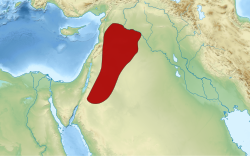
Back تنوخيون Arabic Tanux Azerbaijani Tanúkhides Catalan Tanukové Czech Tanújidas Spanish Tanukhides French ברית שבטי תנוח' HE Bani Tanukh ID Tanukhidi Italian Tanuquitas Portuguese
Tanukh تنوخ | |||||||||||||
|---|---|---|---|---|---|---|---|---|---|---|---|---|---|
| 196 AD–1100 AD | |||||||||||||
 | |||||||||||||
| Capital | Qinnasrin (main base) | ||||||||||||
| Common languages | Arabic | ||||||||||||
| Religion | Arab Paganism, Christianity, Islam, Druze faith[1] | ||||||||||||
| Demonym(s) | Tanukhi | ||||||||||||
| Government | Chiefdom | ||||||||||||
| Chief/King | |||||||||||||
• 196–231 AD | Malik ibn Fahm | ||||||||||||
• 233–268 AD | Jadhima ibn Malik | ||||||||||||
• Until 375 AD | al-Hawari | ||||||||||||
• 375–425 AD | Queen Mavia | ||||||||||||
| Historical era | Classical Age to the Early Middle Ages | ||||||||||||
• Established | 196 AD | ||||||||||||
• Conversion to Christianity | 3rd or 4th century | ||||||||||||
• Revolt of Queen Mavia | 378 AD | ||||||||||||
• Conversion to Islam | 8th century | ||||||||||||
| 1096–1099 AD | |||||||||||||
• Disestablished | 1100 AD | ||||||||||||
| |||||||||||||
The Tanûkhids (Arabic: التنوخيون), Tanukh (Arabic: تنوخ, romanized: Tanūḫ), or Banū Tanūkh (بنو تنوخ, romanized as: Banū Tanūḫ) were a confederation of Arab tribes, sometimes characterized as Saracens. They first rose to prominence in northern Arabia and southern Syria in the 2nd century CE. Both Lakhmid and Tanukhid inscriptions have been found at Umm el-Jimal in Jordan and Namara in Syria. The ancient Tanukh tribal confederation was largely taken over by several branches of the large Azd and Quda'a tribes. Their main base during the time of their most famous ruler, Queen Mavia, was in Aleppo.[2] During the 8th and 9th centuries, the Tanukhid strongholds were the cities of Qinnasrin and Maarat al-Numan.
| Historical Arab states and dynasties |
|---|
 |
- ^ Abu Izzedin, Nejla M. (1993) [1984]. The Druzes: A New Study of Their History, Faith, and Society (2nd ed.). Leiden and New York: Brill. p. 127. ISBN 90-04-09705-8.
- ^ Ball, Warwick (2001), Rome in the East: The Transformation of an Empire, Routledge, ISBN 0-415-11376-8 p. 98-102
© MMXXIII Rich X Search. We shall prevail. All rights reserved. Rich X Search